Endler guppies in nature were found only in one of the lakes of Venezuela. The detrimental effect of man contributed to the disappearance of this species in the wild, so now you can only meet them with aquarists.
Endler guppies are dwarf fish in which both males and females have a bright multi-colored color. This breed is extremely unpretentious in care and prolific.
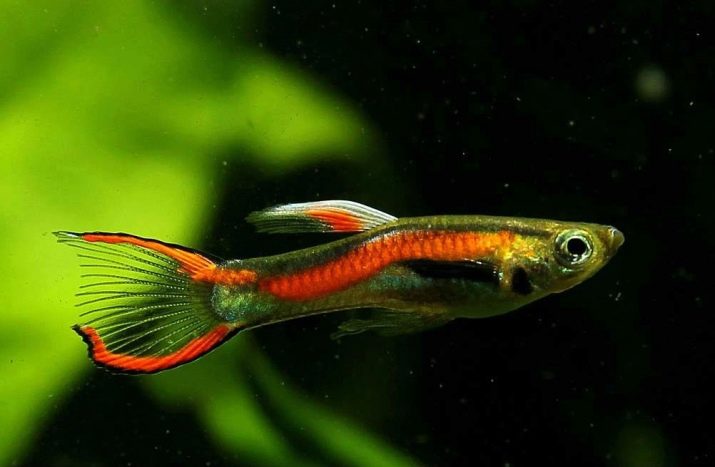
Fish description
Dwarf guppies belong to the family of Peciliae and are freshwater viviparous fish.
The maximum growth of females reaches 4.5 cm, males are less than about 1 centimeter. Life expectancy of males is about three years, in females - about two, since frequent childbirth greatly weaken the body.
The classic Endler guppies are yellow-orange in color with interspersed emerald and purple spots, however, there are many varieties of these dwarf fish with a wide range of colors.
The tail of these fish in shape and splendor is not as beautiful as that of ordinary guppies, it usually has a rounded shape in both females and males.
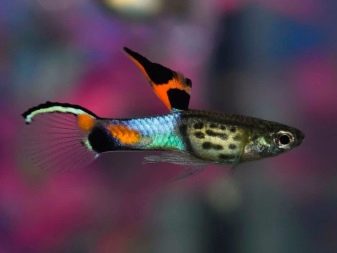
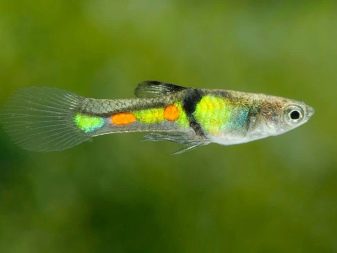
Kinds
There are several types of Endler guppies:
- gold - This is a fish with a golden body color, a light abdomen, a transparent tail with a bright stroke;
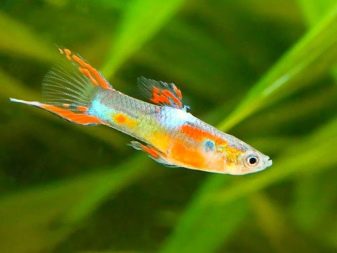
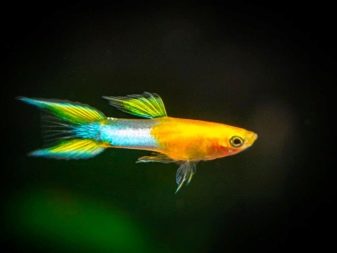
- japanese blue - the head and fins are transparent, the tail is transparent with a bright blue border, has the shape of a double sword, the body is blue with a neon tint, in the middle of the body is a black spot (females are transparent);
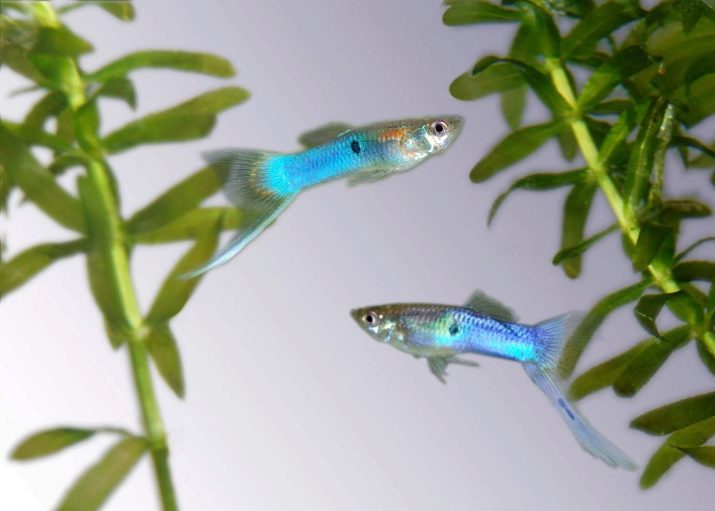
- tiger - body of olive or saturated yellow color, dark abdomen, transparent tail with dark bordering, almost transparent abdominal fin;
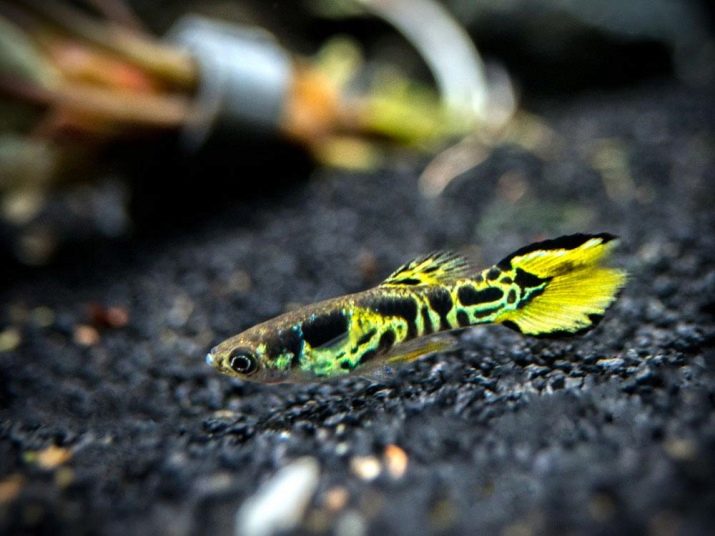
- cobra - the color resembles a snake skin pattern and very beautifully shimmers in daylight, on a yellow background of the body there are dark spots, are completely painted in yellow and fins (except for the abdominal), tail;
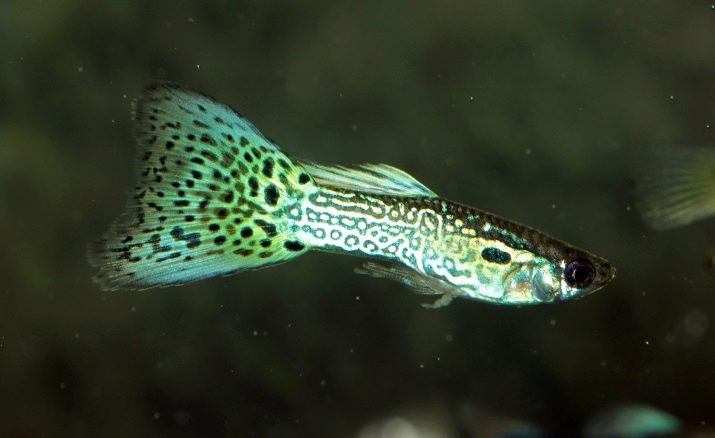
- Venezuela - orange, black and green-yellow colors predominate in its color, the transparent tail is similar to a double sword in shape and has a bright orange fringing, the dorsal fin is partially colored and has an elongated shape, the abdominal is transparent;

- sky blue - these fish have a nondescript body color, fins and tail are painted in a saturated sky blue color.

Hybrids can be born from the same pair of dwarf guppies at the same time as purebred individuals of the same species. An infinite number of combinations in color makes these fish extremely attractive to all aquarists.
Growing conditions
The content of Endler's guppy is extremely simple, the only difficulty is that they need a separate aquarium so that they are not offended by other fish species. Dwarf guppies are peaceful and friendly fish. It is undesirable to hook ordinary guppies to them, since hybrid individuals with weakened health will begin to be born, and many females will die during childbirth.
The neighbors of dwarf guppies can only be slow and calm aquarium inhabitants: neon, zebrafish and shrimp.
It is recommended to contain either one pair of guppies, or at least three females in one aquarium and two males, so that the boys fight less and the girls are less aggressive and stop sharing the aquarium’s territory with each other.
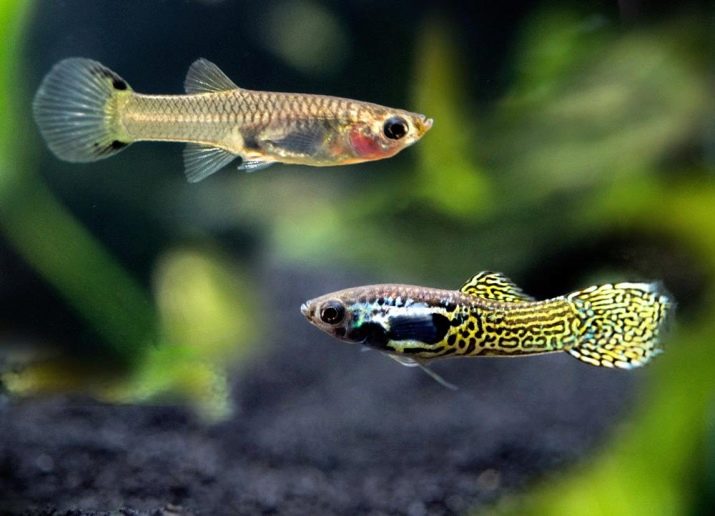
For one fish you need 3 liters of water. The aquarium should be equipped with aeration and a filter. If the fish do not have enough oxygen dissolved in water, they try to jump out of the aquarium, so do not overpopulate the tank. Be sure to close the aquarium with a lid, while leaving a small gap of 2-3 cm or putting the lid on a stand to provide air access, otherwise the water will sour.
The optimum temperature for the content of the Endler guppy is from +23 to +25 degrees. To constantly maintain this temperature, you can purchase a special thermostat. If the water is warmer, then the fish will quickly grow and multiply, but their lifespan will be significantly reduced.
Water hardness for dwarf fish should vary from 15 to 20 dGH, acidity - from 6.7 to 7.5 units.
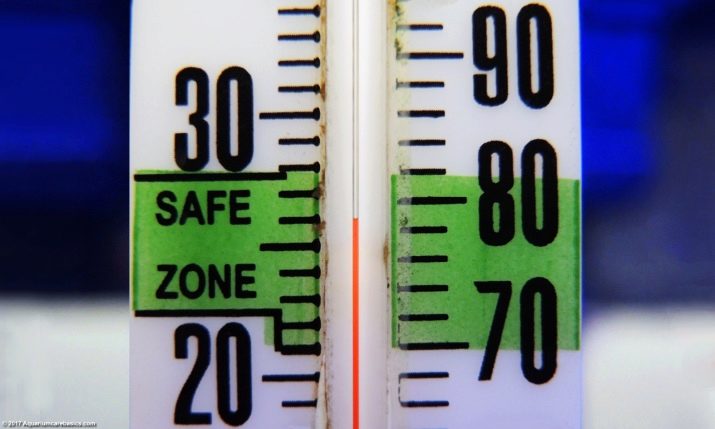
As the soil, it is best to use sea pebbles or ordinary black and gray pebbles (before placing in the aquarium, pebbles must be washed with baking soda, rinsed thoroughly, boiled for 5 minutes, drained water, allowed to cool).
Artificial lighting should be as close to daylight as possible. If the lamp is too bright, the color of the dwarf guppies fades and turns pale, they very quickly lose their beauty.
The filter must be purchased based on the size of the aquarium. Dwarf guppies are very unpretentious and there is relatively little dirt from them, so a simple medium-sized filter that creates a minimum flow is suitable for them. It is not recommended to buy a filter in which an aerator is built-in, such a device saves space only slightly, but its filler clogs much faster, and part of the microalgae comes back with air bubbles into the aquarium.
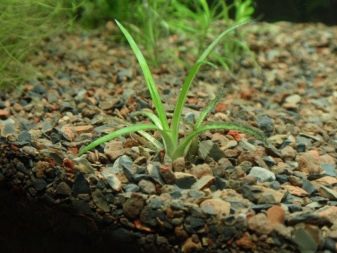
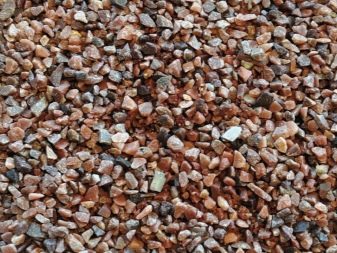
The walls of the aquarium are easily cleaned with a piece of gauze, which allows you to collect the entire coating of microalgae. It is enough to carry out such a procedure once a month.
The bottom is easy to clean with a siphon filter or a simple plastic tubing with a hose (once every 3-4 weeks). After this, add the settled tap water to the usual level in the aquarium.
Cleaning the walls and bottom does not require sedimentation of the fish, it is enough to perform all actions slowly.
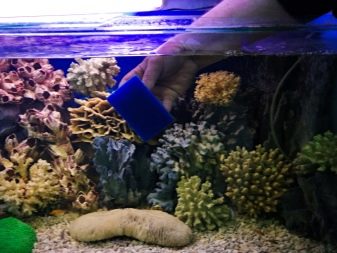

Endler's guppies require quite dense and lush vegetation: all varieties of limnophila, bacopa, wallysneria, moss, hydrotrich, etc.Duckweed can be placed on the surface, but it grows rapidly and needs frequent thinning. It should be remembered that the number of plants depends on the capacity displacement and the number of fish (it is enough to plant two rows of high vegetation along the back wall, a layer at the surface of the water from plants in which fry can hide, and 2-3 stunted bushes in the foreground).
Plastic and painted clay ornaments, as well as multi-colored soil for the aquarium, amaze the imagination with their variety, but often release toxic substances into the water, so it is better to prefer ordinary stones, shells and glass ornaments.
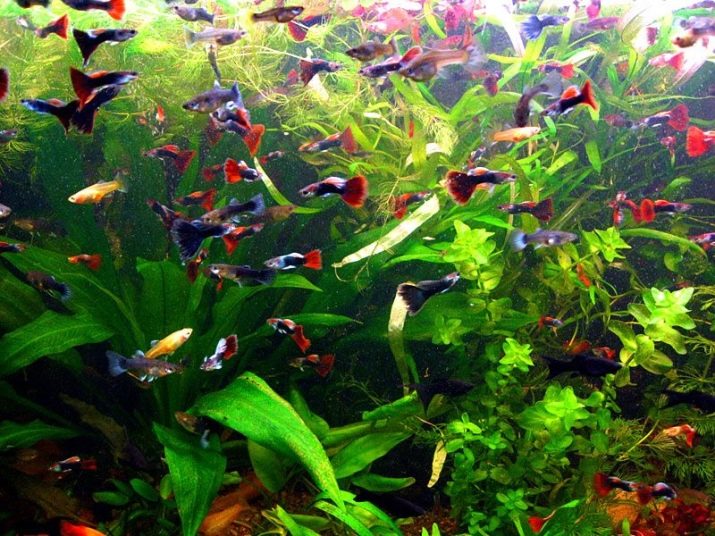
Proper feeding
Newborn fry should be fed already 2 hours after the birth of a special small feed (you can zooplankton "Artemia"). Kids of dwarf guppies grow very quickly, so they need three meals a day. However, overfeeding them is not worth it.
In terms of nutrition, guppies of all ages are unpretentious. The following feeding schedule is recommended:
- dry food is given 1 time per day every other day;
- vitamin mixture in the form of flakes once every two days (alternating with regular dry food);
- live food 1 time per week (it is better to buy small: daphnia moin and nematode, but not all bloodworms, as it is large, and the fish themselves are only 2-3 cm long).
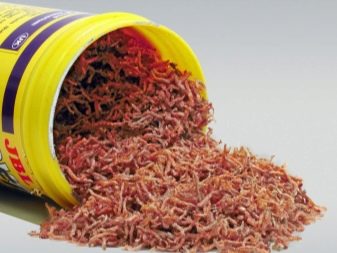
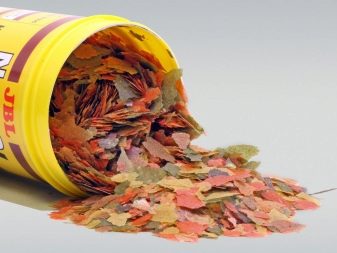
Feeding frozen fish is not recommended. Dwarf guppies are very thermophilic, so cold food will negatively affect their health. You can sometimes feed them raw, scraped meat. To do this, use a sharp knife to scrape off a little meat from a frozen piece of beef, let it warm to room temperature and feed them fish. You can’t store such food. It is better to give live food to small fish individually, so that extra worms do not settle to the bottom and do not rot there. One fish is enough for 1 worm per week.
If the owners are often absent due to business trips and trips, an automatic battery-powered feeder will come to the rescue.
It is recommended to leave a piece of the bottom under the feeder free from soil in order to see excess food and stop feeding on time. Also, this technique will facilitate cleaning in the aquarium.

How to distinguish a male from a female?
Males and females differ in the shape of the ventral fin: in males, the fins on the abdomen are elongated, in females, they are rounded.
Endler’s dwarf guppy males are noticeably smaller in size than females, and much more brightly colored. Females of many subspecies are completely transparent - you can see with their naked eyes all their insides and spine.
The scales of males are poured by neon reflections, the scales of females (if they are not transparent) most often have only a faded silver or golden hue without overflow.
Females on the abdomen have a black speck in the area of the anus, with the onset of pregnancy and an increase in its term, it grows. Males are constantly on the move, they are always ready for breeding and actively care for slow females.
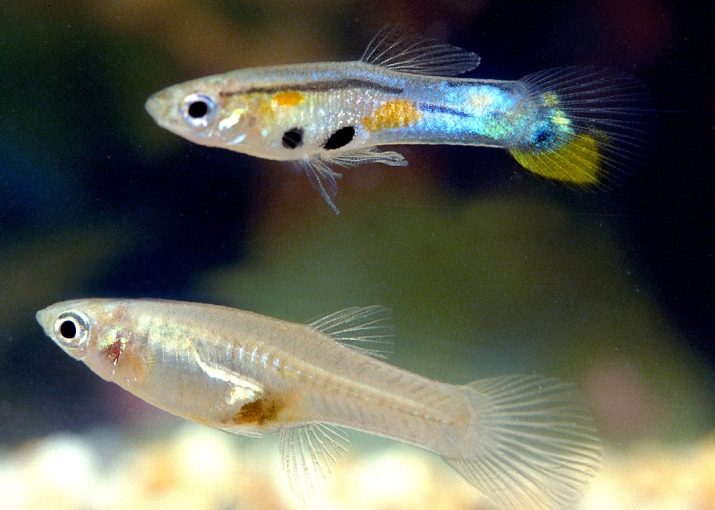
Breeding
Guppies are viviparous fish, so it is necessary to plant a pregnant female on time in a separate container or to catch fry in a timely manner from a common aquarium. If the birth takes place in an ordinary aquarium, it is necessary to place a thick layer of algae (duckweed, "herringbone") so that the young can hide in them and survive. At the moment of birth, the fry, twisted into a ball, rolls out of the female, hits the bottom, unwinds and pops up very quickly. Under natural conditions, dwarf guppies do not take the kids away with the current, like the classic guppies, however, adults can pursue them, defending their territorial rights. If the juveniles are planted on time, they will be very easy to grow.
A few days before the birth, the female begins to lose balance and swim, slightly falling over to one side, or with an inclination forward. At this time, the black spot near the anus reaches its maximum size.
A layer of algae at the surface of the water is also needed in the delivery container. Childbirth often occurs late in the evening. Immediately after their completion, the female must be transplanted into another similar container, since the birth of dwarf guppies can take place in 2-3 stages for several days. For some births, the female can reproduce from 5 to 25 fry.
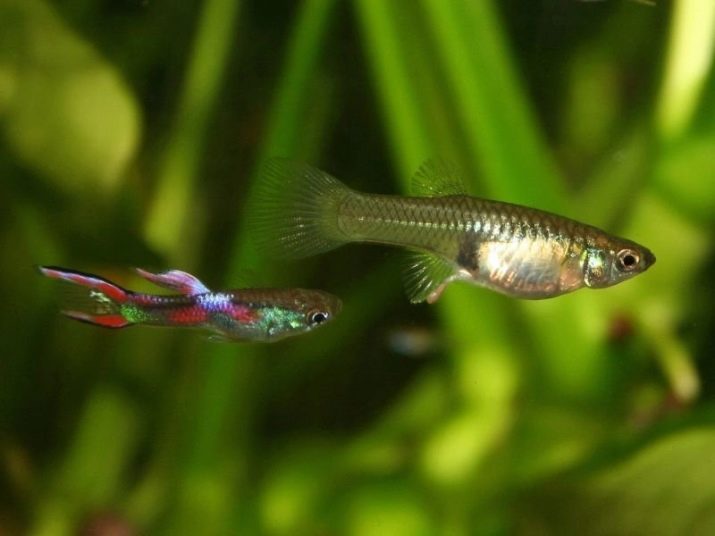
Females of dwarf guppies are able to give birth every month, but to get stronger offspring it is better to give her a month of rest between pregnancies, to keep in a separate container about 30 days after giving birth, so that her body can fully recover. One fertilization may be enough for several litters.
At the age of two months, juvenile guppies gain the ability to reproduce, but early pregnancy adversely affects their health and the resulting offspring, so it is recommended that males be removed from females at the age of 1.5 months. Breeding is best started at 3 months, when the body of the fish finally gets stronger.
Endler's dwarf guppies are very beautiful fish, they are easy to maintain, they breed quickly. Such aquarium inhabitants are suitable for beginner aquarists, but experienced fish owners love them for their extraordinary variety of colors and the shape of their fins. Small bright fish will be the decoration of any aquarium and will not cause the owner extra trouble.
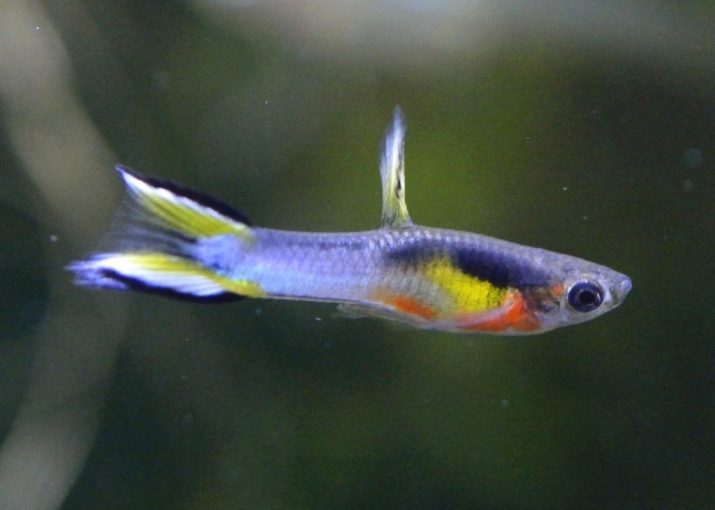
You can look at the beauty of Endler's guppy further.










